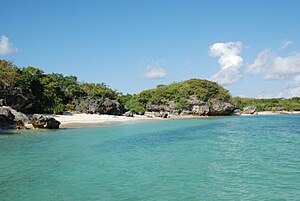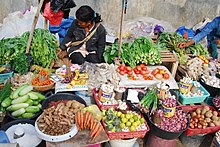Roti (island)
| Roti | |
|---|---|
| Roti satellite image | |
| Waters | Timor Sea , Sawu Sea |
| Archipelago | Timor Archipelago |
| Geographical location | 10 ° 28 ′ S , 123 ° 23 ′ E |
| surface | 1214 km² |
| Highest elevation | 444 m |
| main place | Ba'a |
| Nusa Manuk Beach | |
Roti (also Rote , Bahasa Indonesia Pulau Roti ) is an Indonesian island off the western tip of Timor .
geography
The island of Roti has an area of 1214 km². The highest point reaches 444 m . North is the Savu Sea , south of the Timor Sea , further to the west lie the islands Sawu and Sumba . To the northeast, Roti separates the Strait of Roti from its direct neighbors Timor and Semau.
There are several smaller islands around Roti. To the west are the islands of Ndao , Nuse (Nusa) and Doo , to the east Usu , Nusa Manupui and Boti , to the north Ndoa , Nusa Kodi , Huana , Batuhun and Nusa Bibi and to the southwest Pamana (Dana, Dona, Ndana), Helihana , Landu , Manuk , Batu Bibi , Liu , Nusa Nak and Lai . Pamana is the southernmost island in Indonesia.
Roti and its neighboring islands form the administrative district ( Kabupaten ) Rote Ndao in the province of East Nusa Tenggara of the Lesser Sunda Islands . The main town is Ba'a in the northern center of the island. There is a surfing area south of the village of Nemberala . A daily ferry connects the island with the provincial capital Kupang in West Timor .
The short rainy season lasts from December to March. During this time, streams and rivers form, which disappear again in the dry season. There are a few small lakes that exist all year round, but most of the island is dry. The largest is Lake Usipoka ( Danau Oesipoka ) at 20 m above sea level on the Tapuafu peninsula in northeast Roti. With a content of 18.8 g / kg, the water is very salty, there may be a connection to the sea. The water depth is up to 245 m .
The highest mountain is the Musaklain with 444 m in the district of Rote Selatan (South Roti).
population
The majority of the native Rotinese are Christian and speak the central Malayo-Polynesian language Rotinese , which is divided into several dialects ( Bilba , Dela-Oenale , Dengka , Lole , Ringgou , Termanu , Tii ). But there are also immigrants from other islands in Indonesia. More of the 123,000 Rotinese live around Kupang in West Timor and on the island of Semau .
Another native language on Roti is Ndao (self-designation Dhao ), which is mainly spoken on the neighboring island of Ndao . Bini is a ritual language with its own vocabulary, which is understood as the "language of the ancestors". Verses sung in bini are accompanied by the national instrument of the Rotinese, the bamboo zither Sasando .
history
In 1681 the Dutch conquered the island of Roti, from where slaves were brought to Timor . In addition, the Dutch recruited soldiers for their army and built schools on Roti after the local ruler converted to Christianity in 1729. The Rotinese became a well-educated elite. In order to use this as a counterbalance to the Timorese, the Dutch encouraged their immigration to West Timor, so that they and their language are still present here today.
Between 1746 and 1749, the Topasse failed when trying to gain control of Roti from West Timor .
economy
In addition to surfing tourism, agriculture is the main source of income. Fishing plays a major role in the village of Pepela , which is why there have been disputes with Australia .
fauna
The McCord's snake neck turtle ( Chelodina mccordi ), which occurs on Roti and Timor , was only described in 1994 and is threatened with extinction. An endemic of the island is the peacock monitor . The Timor water python ( Liasis mackloti ) is also a striking representative of the Rotis fauna . The crawling cat species Paradoxurus musangus was introduced from Java by humans in prehistoric times . In 2004 a new endemic warbler species was discovered on Roti , which was first described in 2018 as Phylloscopus rotiensis .
Web links
Individual evidence
- ↑ a b A. GJ Rhodin, BR Ibarrondo, G. Kuchlin: Chelodina mccordi Rhodin 1994 - Roti Island snake-necked turtle, McCord's snake-necked turtle, kura-kura red. In: AGJ Rhodin, PCH Pritchard, PP van Dijk, RA Saumure, KA Buhlmann, JB Iverson (eds.): Conservation Biology of Freshwater Turtles and Tortoises: A Compilation Project of the IUCN / SSC Tortoise and Freshwater Turtle Specialist Group. (= Chelonian Research Monographs. No. 5). 2009, pp. 008.1–008.8. doi: 10.3854 / crm.5.008.mccordi.v1.2008 ( ISSN 1088-7105 ) (English)
- ↑ Map of Roti ( Memento of the original from December 9th, 2015 in the Internet Archive ) Info: The archive link was inserted automatically and has not yet been checked. Please check the original and archive link according to the instructions and then remove this notice. , accessed March 17, 2013.
- ^ Map of Roti ( Memento of December 16, 2010 in the Internet Archive ), accessed on March 17, 2013.
- ↑ Jane's oceania - Timor
- ^ Jill Elliott: Fishing in Australian Waters. In: Inside Indonesia. vol. 46, 1996.
- ↑ Richard Tanter: After fear, before justice: Indonesia and Australia over the long haul, as if ethics mattered. In: Inside Indonesia. vol. 61, 2000.
- ↑ Géraldine Veron, Marie-Lilith Patou, Mária Tóth, Manori Goonatilake & Andrew P. Jennings: How Many Species of Paradoxurus Civets are there? New Insights from India and Sri Lanka. Journal of Zoological Systematics and Evolutionary Research, 1-14, 2014 doi : 10.1111 / jzs.12085








